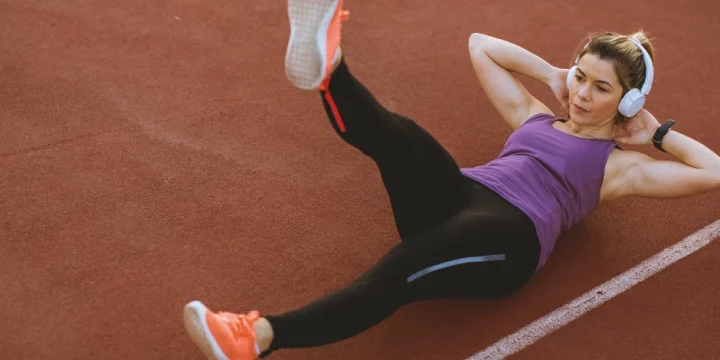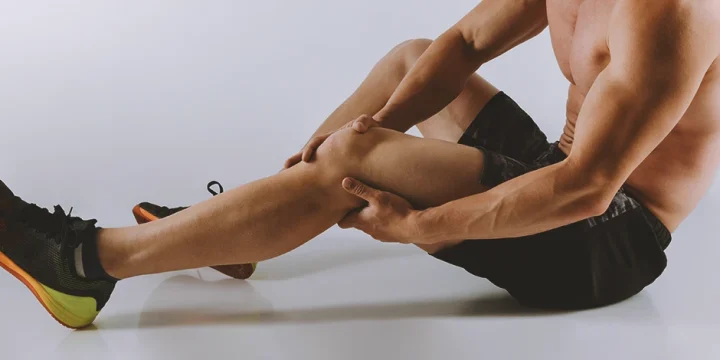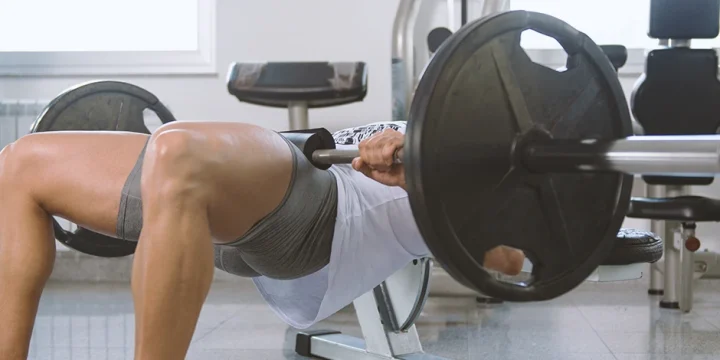As an experienced personal trainer, one common request I receive is providing an intense back workout using lat pulldown variations.
After putting it to the test, I’ve learned these exercises and variations are incorporated into workout routines to get a well-sculpted body.
I checked what the scientific resources say and talked with other fitness experts. I’ll also share what I’ve discovered through trial and error about the best lat pulldown variations, so you'll have a comprehensive guide to intensify your back workouts.
Quick Summary
- Lat pulldown variations include single-arm lat pulldown, kneeling lat pulldown, mini band lat pulldown, crossover lat pulldown, and more.
- Different grips in lat pulldowns, such as wide, neutral, reverse, and close grips, target specific muscle groups for optimized results.
- The average lat pulldown weight for a beginner male lifter is 85 lb, and 243 lb for advanced lifters.
- In my opinion, regularly switching between these lat pulldown variations can prevent workout monotony and lead to more balanced muscle development.
Best Lat Pulldown Variations to Try [+ Proper Form]

I have tried and tested numerous lat pulldown exercise variations, and each has its own unique aspect you must consider before performing it [1].
It doesn’t matter if you're an 18-year-old starting your fitness journey or a seasoned gym-goer, these variations cater to all fitness levels.
Cable Straight-Arm Lat Pulldown
I remember working with a client who struggled with traditional pulldowns, but when we switched to this variation, they noticed a significant improvement in their form and muscle engagement.
Ensure your arms remain straight but not locked throughout the exercise.
To perform it:
- Keep your back straight
- Pull the cable bar down to your thighs using a pronated (overhand) grip
- Slowly return to the starting position
Mini Band Lat Pulldown
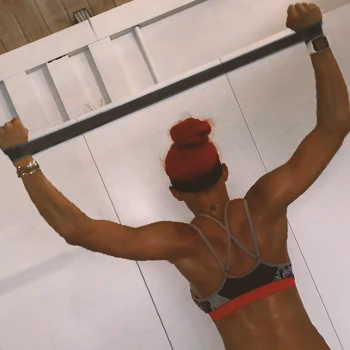
This exercise focuses on upper back, shoulders, and the lats.
I've had clients who were amazed at how this simple tool intensified their workout, especially in targeting the upper back and lats.
The mini band’s resistance will challenge your muscles in a way that a normal lat pulldown won’t.
Here’s how to do it:
- Fasten the mini band around your wrists
- Extend your arms overhead
- Pull down until your elbows reach your sides
Resistance Band Lat Pulldown
I often recommend this for home workouts. It's surprising how effectively it mimics a cable machine, providing a solid lat workout without the gym equipment.
To perform it:
- Secure your favorite home gym resistance band overhead
- Grasp the band with both hands
- Pull it down to your chest
- Maintain constant tension on the band for better results
Read More: Resistance Band Back Exercises
Kneeling Lat Pulldown
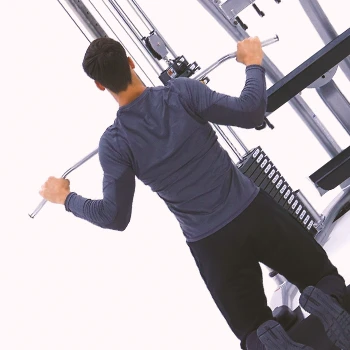
The kneeling lat pulldown variation reduces the engagement of the lower back and increases the focus on the lats.
I recommend this variation to clients looking to isolate their lats.
Here’s how to do it:
- Kneel before the preferred cable machine
- Grasp the bar
- Pull it down to your chest while keeping your torso still
Single-Arm Lat Pulldown
I've used this with clients to correct muscle imbalances. Focusing on one side at a time brings remarkable symmetry and strength gains.
To perform it, pull the handle down with one arm while keeping your torso stationary. Feel the burn in your lats.
Related: Straight Arm Lat Pulldown Guide
Chest-to-Bar Lat Pulldown
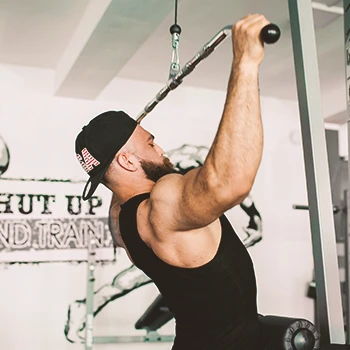
The chest-to-bar lat pulldown is a challenging variant targeting the upper lats and middle-upper back muscles.
To perform the exercise:
- Draw the bar down towards your upper chest
- Squeeze your shoulder blades together
- Slowly return the bar to the starting position
- Keep your chest puffed out throughout the movement
Tall-Kneeling Dual Cable Lat Pulldown
I've found that this variation not only works the lats but also engages the core significantly, offering a more holistic workout.
To perform it:
- Kneel between two cable machines
- Grab the handles
- Pull them down simultaneously
- Keep your core engaged to stay balanced
Crossover Lat Pulldown
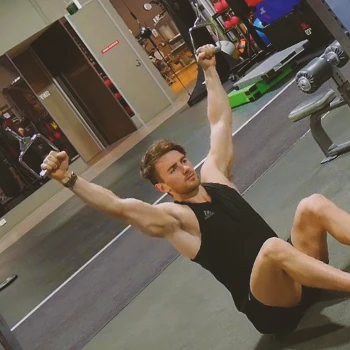
The crossover lat pulldown targets the lats from a unique angle.
It also works out shoulders and traps, giving you killer back training.
Here’s how to do it:
- Stand between two cable machines
- Cross your arms to grab the opposite handles
- Pull the handles down
Learn More: Best Cable Crossover Machines For Home Gyms
Killer Lat Pulldown Variation Routine

Here’s a killer lat pulldown variation routine you can do when trying traditional lat pulldowns alternatives.
Warm-up
1. Arm Circles (1 minute in each direction)
Position yourself with feet shoulder-width apart, extend your arms outwards, and create small circular motions with them. After a minute, reverse the direction.
This will help warm up your shoulder joints.
2. Band Pull-Aparts (2 sets of 15 reps)
Stand upright, and hold a resistance band with both hands extended straight in front of you.
Maintain your arms straight without bending your elbows, draw them apart while contracting your shoulder blades together, then gradually go back to the initial stance.
3. Cat-Camel Stretch (2 sets of 10 reps)
Get on your hands and knees, round your back towards the ceiling, hold for a moment, then arch your back while lifting your chest and eyes towards the ceiling.
This will help mobilize your spine and warm up your back.
4. Scapular Retractions (2 sets of 10 reps)
Stand or sit with your back straight. Keep your arms relaxed by your sides, squeeze your shoulder blades together, and then release.
This warms up the muscles around your shoulder blades, vital in lat pulldown movements.
Workout
- Cable Straight-Arm Lat Pulldown: 3 sets of 10-12 reps
- Chest-to-Bar Lat Pulldown: 3 sets of 10-12 reps
- Single-Arm Lat Pulldown: 3 sets of 10-12 reps per arm
- Crossover Lat Pulldown: 3 sets of 10-12 reps
Lat Pulldown Grips to Use When Training

According to a study on Research Gate, you can use different grips while performing lat pulldowns, each offering unique benefits and targeting your muscles in slightly different ways [2].
Wide Grip Lat Pulldown
“The highest latissimus dorsi to biceps ratio of activation occurred during the wide grip pulldown and the seated row.”
- Dr. Greg Lehman, Doctor of Chiropractic
The wide-grip lat pulldown is how most people learn to perform this exercise.
Wide grip lat pulldowns require you to position your hands wider than shoulder-width apart. You'll primarily target your latissimus dorsi (the "lats"), helping to create a broad, V-shaped back.
According to a study in the National Library of Medicine, this grip also involves the infraspinatus and teres major, two smaller shoulder muscles [3].
Neutral Grip Lat Pulldown
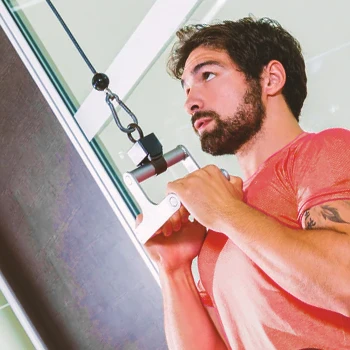
I've found this grip particularly useful for clients looking to engage a broader range of back muscles.
The neutral grip (palms facing each other) engages your lats, middle and lower trapezius, rhomboids, and serratus anterior muscles.
Reverse Grip Lat Pulldown
The reverse grip lat pulldown uses an underhand or supinated grip.
The underhand grip has been a game-changer for many of my clients, especially for emphasizing the lower lats and incorporating bicep work.
Close Grip Lat Pulldown
The close grip lat pulldown is performed with your hands closer than shoulder-width apart. It shifts the focus from the outer lats to the central back muscles.
This grip targets the rhomboids and middle trapezius, critical for good posture and spinal stability.
Benefits of Training Using a Lat Pulldown Variation

Training with a lat pulldown variation offers significant benefits, such as:
- Muscle Activation: Different variations target your lats uniquely, ensuring complete muscle activation [4].
- Avoid Plateau: Avoid the dreaded training plateau and challenge your muscles by changing your routine with different variations.
- Improved Form: The variety in lat pulldown exercises helps to enhance your form, boosting the effectiveness of your workouts.
- Injury Prevention: Different lat pulldown variations balance muscle development, reducing the risk of injury due to muscular imbalances.
- Versatility: Lat pulldown variations are adaptable to different fitness levels and can be modified based on individual needs and goals.
What Muscles Are Trained While Doing Lat Pulldowns?

Lat pulldowns train biceps, forearms, lats, traps, delts, and rhomboids and here’s how:
Biceps
The pulling movement in lat pulldowns engages your biceps, helping you increase strength and definition in your arms.
Moreover, varying the grip in the exercise stimulates different parts of these muscles, providing a more balanced development.
Forearms
You work your forearm muscles by holding and pulling the bar, improving grip strength. This strengthening can also benefit other exercises that require a firm grip, like deadlifts.
Latissimus Dorsi

As the primary muscle worked during lat pulldowns, the latissimus dorsi (or 'lats') gets significantly strengthened, contributing to a wider back and better posture.
Lat pulldowns assist in developing the "V" shape in the back.
Traps
The trapezius muscles in your upper back get activated as you control the movements. This provides neck stability and good posture.
Posterior Delts
Although not the main focus, the rear deltoids get a workout when you pull the bar down. This helps balance the development of shoulder muscles and prevent injuries.
Rhomboids
The rhomboids activate when you squeeze the shoulder blades at the end of the pull movement. This improves scapular retraction, which is helpful for posture and shoulder stability.
Tips to Improve Your Lat Pulldown Variation Results

Here are a few helpful tips to enhance your performance while doing lat pulldown variations based on what Peter Ronai said.
- Mind-Muscle Synergy: Don't just go through the motions. Focus on the muscles you're working. Visualize them contracting and releasing with each rep.
- Control Your Movements: Avoid using momentum or jerky movements to lift the weight. Instead, focus on a smooth, controlled movement throughout the entire rep.
- Adjust Your Grip: Don't stick to one grip. Experiment with wide, neutral, reverse, and close grips. Different grips target your muscles from different angles, promoting balanced muscle development.
- Maintain a Proper Form: Keep your chest up, your back straight, and your shoulder blades pulled back during the exercise. This ensures you're targeting the right muscles.
- Avoid Overloading: While it's crucial to challenge yourself, lifting too much weight can compromise your form and lead to injury. Pick a weight that helps you perform the exercise correctly while still feeling challenged. It’s better controlled and lighter weight than anything else.
- Regularly Switch Variations: Regularly switch up your lat pulldown variations. This will keep your muscles surprised and encourage continued growth and strength gains.
- Try post-workout drinks: We recommend Transparent Labs, Jacked Factory, or Optimum Nutrition for post-workout recovery.
“The lat pulldown is an open kinetic chain, multi-joint exercise that is appropriate for novice, intermediate, and advanced level exercisers. It can be performed with a number of types of equipment and requires minimal equipment to perform.”
- Peter Ronai, Professor at the Department of Exercise Science
Combining Lat Pulldowns with Other Exercises
When it comes to developing a strong, well-defined back, focusing solely on lat pulldown variations might not be enough.
Here's how you can integrate lat pulldowns with other exercises for a balanced back training routine:
Pairing with Rowing Exercises
Rowing movements complement lat pulldowns by targeting the middle and lower back muscles. After performing a set of lat pulldowns, switch to a rowing exercise like the bent-over barbell row or seated cable row.
This combination ensures a balanced workout that hits all the major muscles in the back.
Incorporating Deadlifts
Deadlifts are excellent for overall back development, working everything from your lats to your lower back.
Integrating deadlifts into your routine, perhaps on a different day than your lat pulldowns, can provide comprehensive back strength and improve posture.
Super Setting with Pull-Ups or Chin-Ups
Pull-ups and chin-ups are classic exercises that effectively target the upper back and lats. Try super setting lat pulldowns with pull-ups or chin-ups.
This means doing a set of lat pulldowns immediately followed by pull-ups without rest, which can intensify your workout and stimulate muscle growth.
Balancing with Anterior Chain Exercises
Finally, ensure that you're not just focusing on your back. Balance your routine with exercises that target the anterior chain, like push-ups or chest presses.
This approach helps in maintaining a good posture and reducing the risk of muscle imbalances.
Related Articles:
FAQs
Which is the Best Lat Pulldown Variation?
The best lat pulldown variation is subjective and depends on individual fitness goals and the specific muscles you aim to target. A wide grip lat pulldown is recommended for targeting outer lats, while the close or reverse grip is preferable to emphasize the middle back or rhomboids.
Can I Still Train with the Lat Pulldown Machine?
Yes, you can still train with the lat pulldown machine. The traditional lat pulldown is a staple in many workout routines due to its effectiveness in targeting the back muscles, particularly the latissimus dorsi.
Which is the Best Grip for Lat Pulldown Variations?
The best grip for lat pulldown variations depends on the muscle trained. For example, the wide grip lat pulldown is excellent for a back workout, while the reverse grip focuses on the biceps and lower lats.
References:
- https://www.researchgate.net/publication/331426919
- https://www.researchgate.net/publication/360676752
- https://www.ncbi.nlm.nih.gov/pmc/articles/PMC449729/
- https://www.researchgate.net/publication/282178642
About The Author
You May Also Like


